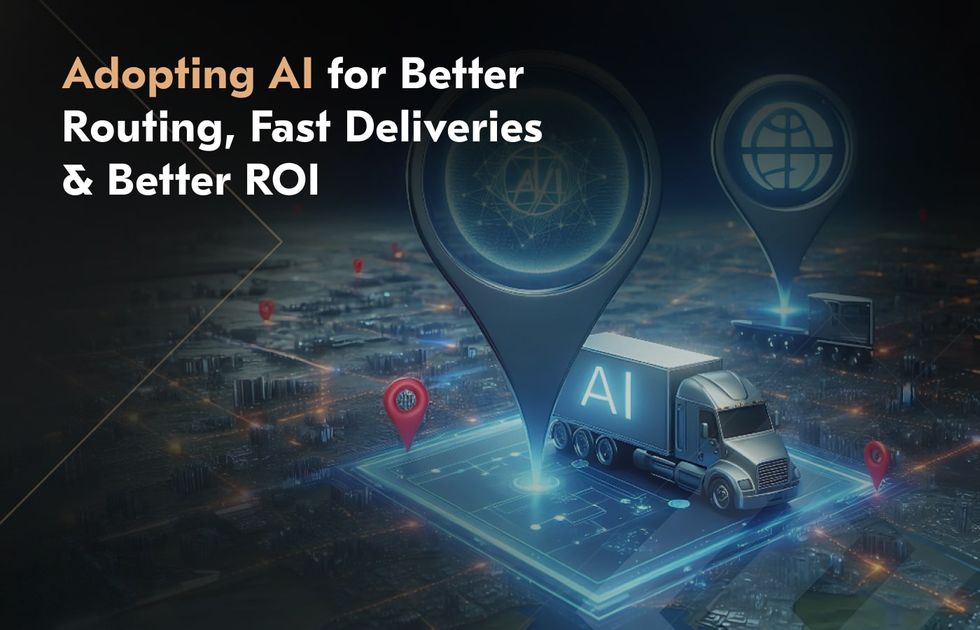
Key Takeaways
- The AI in supply chain dominance index has surged 104.38% over the past five years.
- Amazon’s AI routing enables delivery of 2 billion+ items with same- or next-day shipping, and Prime members saved up to $95 billion on free delivery in 2025.
- Acropolium’s client adopted AI to modernize their routing strategy and saw their profit margin rise by 15%.
- The global route optimization software market is set to grow from $8.02 billion in 2025 to $15.92 billion by 2030.
Gone are the times when logistics were associated with point A and point B in goods movement and delivery. Today, routing is about efficiency that happens in between, where the vehicle utilizes its maximum capacity and wastes as little resources as possible.
Managing multiple drivers, varied destinations, strict time windows, and unexpected delays can quickly turn into chaos. That’s what AI route planning has come to deal with in 2025 — to strengthen the impact of GPS modules, optimize routes, and cut expenses.
AI-driven route optimization modernizes the transportation cycle and turns the planning guesswork into a data-based strategy that contributes to supply chain efficiency. As Acropolium explores the impact of AI on logistics software development, we want to show you how its adoption can translate to business success.
Let’s see how cutting-edge algorithms transform different ends of the supply chain by starting with the basics — smart routing.
What is AI Route Optimization?
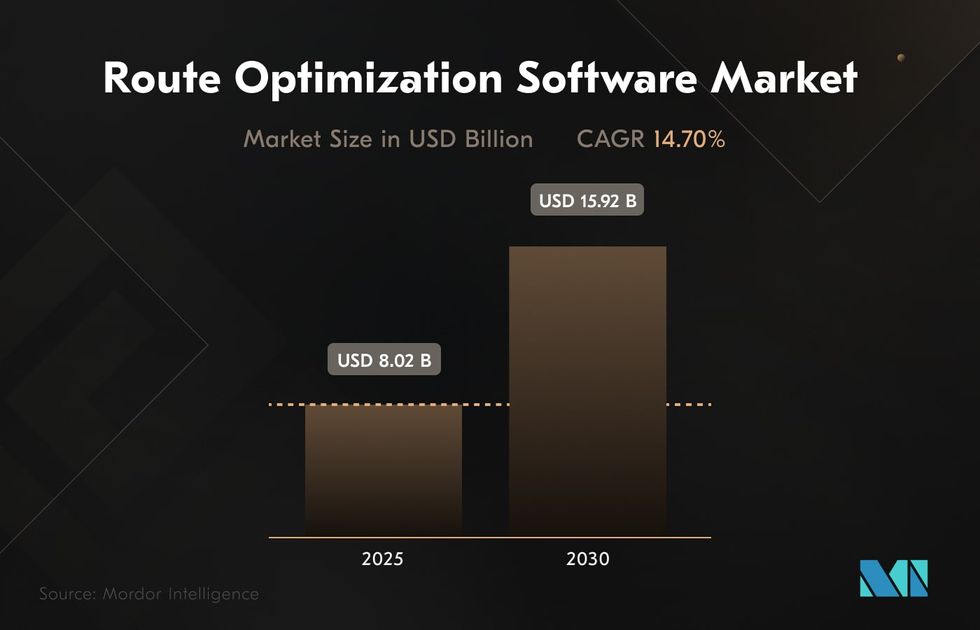
AI route planning and optimization goes far beyond simple GPS navigation. AI tools process both historical trends and real-time conditions to adjust routes on the fly, helping businesses stay agile and competitive.
That’s why 93% of service professionals using artificial intelligence globally say it helps them save time. And with the AI dominance index growing by 104.38% in the past five years, it’s clear the technology is gaining serious traction, with 49% of supply chain actors prioritizing AI investments.
It’s no surprise the global route optimization software market is projected to nearly double, from $8.02 billion in 2025 to $15.92 billion by 2030. With e-commerce and retail booming and consumer expectations rising, industries like food delivery and retail are turning to AI as a must-have tool to meet demand and streamline operations.
Let’s take a look at how route optimization AI reshapes modern transportation management.
How AI Routing Works
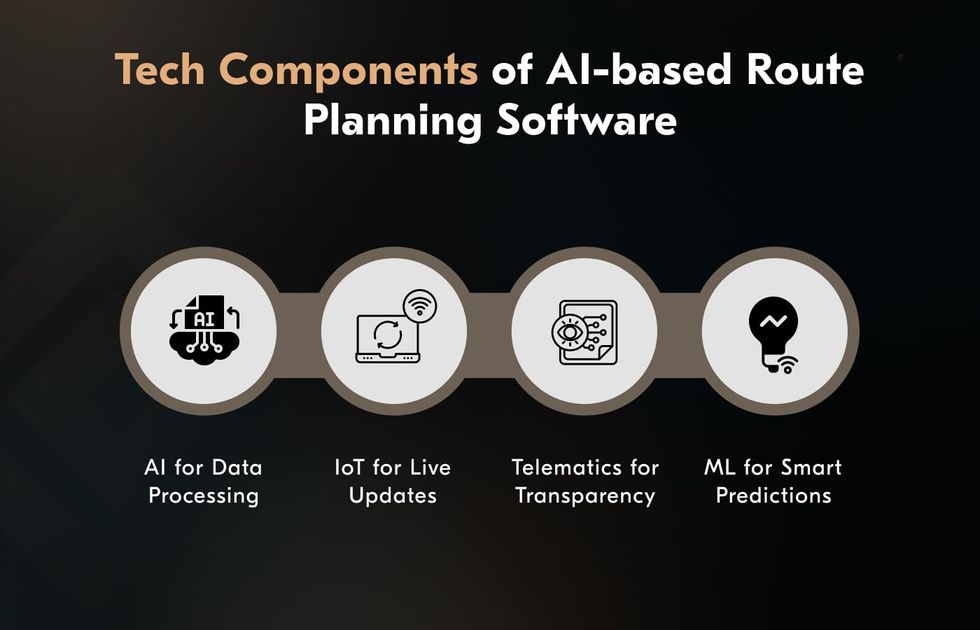
AI route optimization software encompasses a variety of tech modules where each is responsible for separate data processing tasks to deliver accurate insights. First, AI gathers patterns on the road, focusing on critical KPIs like external conditions and vehicle health. Then machine learning steps in, learning from past trips to continuously improve routing decisions.
With IoT and telematics feeding in live updates — from vehicle performance to road conditions — the system can adjust routes instantly to avoid delays or inefficiencies. Add generative AI to the mix, and these tools can even simulate scenarios, predict disruptions, and suggest smarter alternatives on the fly.
Why Switch to AI-Driven Route Optimization
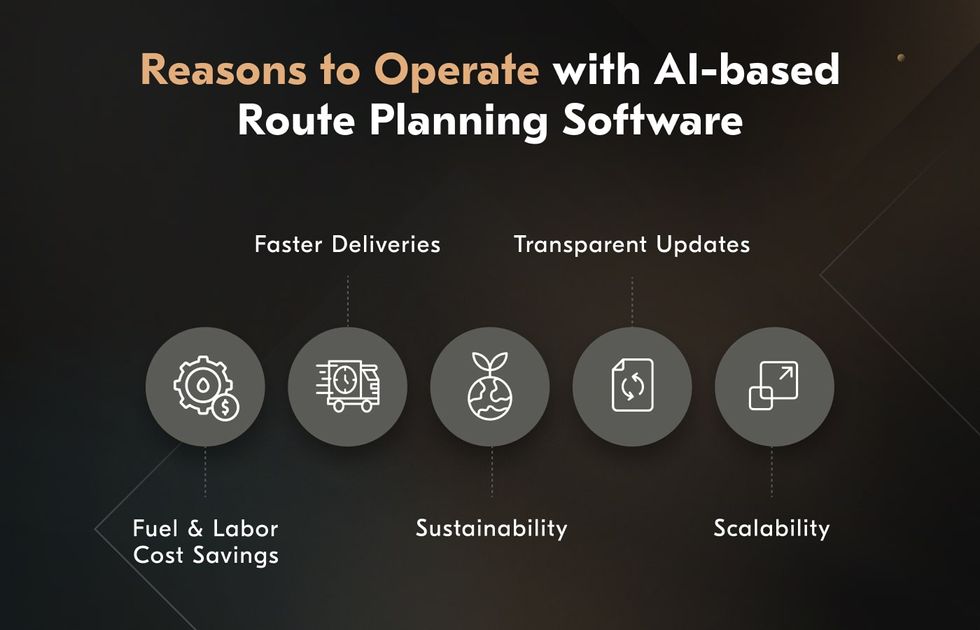
By combining machine learning, IoT sensors and telematics feeds, and advanced AI in route optimization gives you a fully automated, self-improving backbone for your fleet. The result is leaner operations, happier customers and the freedom to focus on growth instead of firefighting logistics.
Big Savings on Fuel & Labor
Rather than relying on static, manual route plans, AI analyzes historical trip data, vehicle loads and live traffic to trim unnecessary miles. Fewer miles driven means lower fuel bills, with last mile delivery cost accounting for 41% of overall logistics expenses. On the labor side, optimized schedules reduce overtime and idle time, helping you keep payroll in check without burning out drivers.
Faster, More Reliable Deliveries
Route optimization AI tools continuously monitor conditions like accidents or last-minute order changes. When the system spots a potential holdup, it reroutes your drivers instantly, shaving off minutes (or even hours) from delivery windows.
Over time, you build a track record of hitting promised time slots, which directly translates into repeat business and higher on-time delivery rates.
Lower Carbon Footprint
Every mile saved is a win for both your bottom line and the environment. By eliminating detours, reducing idling, and lowering total vehicle mileage, you cut CO₂ emissions fleet-wide. In sectors where sustainability goals are mandatory or customer-driven, these reductions can form a key part of your ESG reporting and brand story.
Happier Customers & More Transparency
Modern consumers expect updates at every step. In fact, 82% of supply chain agents say that customers are more demanding than ever before.
With ETA from AI route planning software — along with predictions and live tracking powered by your telematics network — you can offer accurate, minute-by-minute delivery windows. That visibility slashes “Where’s my order?” calls, reduces customer anxiety, and boosts satisfaction scores, turning one-time buyers into loyal advocates.
Scalability & Operational Flexibility
Be it a regional operation running a handful of vans or a global courier managing thousands of vehicles, AI scales to particular needs. You don’t need to rebuild your planning process every time you add a new depot or expand your service area.
And when sudden peaks hit, like holiday rushes, promotional spikes or emergency deployments, the system flexes instantly, reallocating resources without the usual headaches.
AI Route Optimization Use Cases by Industry
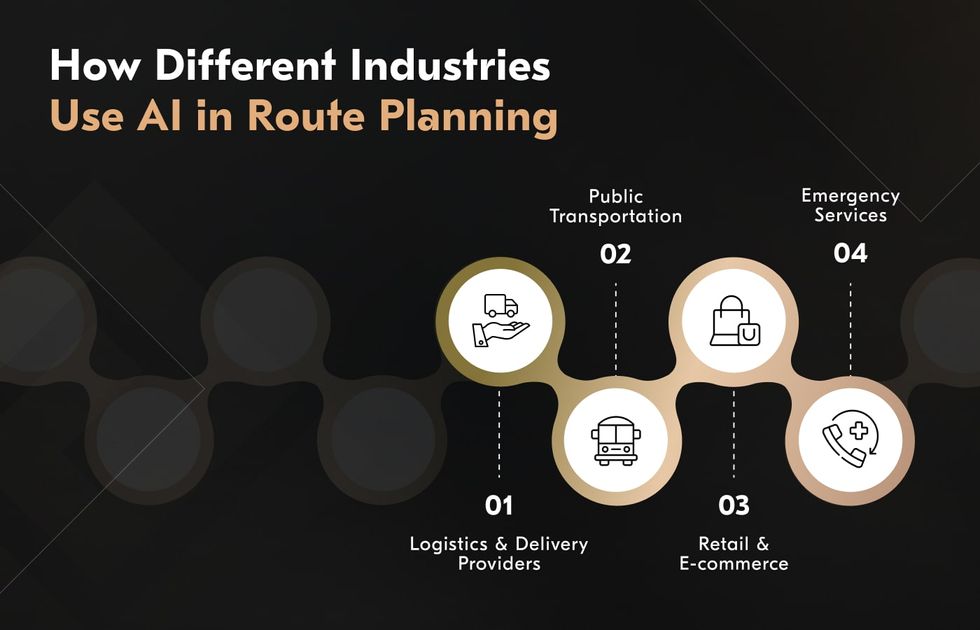
From logistics giants like UPS to public services like Transport for London, businesses all across the board employ AI, ML, telematics, and IoT to streamline routes and deliver better experiences.
Whether it’s ensuring technicians arrive on time, packages get to customers faster, or emergency teams reach the scene more quickly, AI route planning helps organizations operate with greater speed, precision, and flexibility.
Logistics and Delivery Services
In high-volume logistics, every minute counts, and so does every mile. Companies like FedEx and UPS use AI-powered routing to make sure their drivers follow the most efficient path while accounting for traffic, road closures and weather.
UPS utilizes its proprietary AI system, ORION (On-Road Integrated Optimization and Navigation), to enhance delivery efficiency. This system has enabled UPS to reduce the distance traveled by delivery trucks by approximately 100 million miles annually, resulting in significant fuel savings and reduced emissions.
Field Service Management
For utility companies or appliance repair services, every wasted trip is lost revenue. Operating with route optimization using AI dispatchers assign jobs to the right specialist based on location, skill set and traffic conditions.
For example, a telecom provider might use AI to adjust routes for in-field teams when cancellations or emergencies pop up, squeezing more appointments into a single day without overwhelming their staff.
Public Transportation
Cities like London and Singapore use AI to adjust bus and train routes based on passenger flow, peak hours, and real-time congestion. The systems analyze crowd data from IoT sensors and ticketing platforms, helping transit authorities reroute or reschedule services to reduce delays and overcrowding, especially during rush hours.
Retail and E-commerce
As customers expect same-day or next-day delivery, AI helps retailers like Amazon optimize last-mile delivery and warehouse dispatching. When a buyer places an order, the system calculates which warehouse should fulfill it, which driver should deliver it, and which route gets it faster, all while factoring in current demand and traffic.
Amazon’s AI routing systems analyze customer orders and warehouse inventory to determine the most suitable routing and fulfillment strategies. This allowed the company to deliver over 2 billion items with same-day or next-day shipping, fostering quicker turnarounds and lower per-order costs.
Moreover, in 2025, its automation policies helped its prime members save up to $95 billion on free delivery.
Emergency Services
In emergencies, seconds can save lives. AI route optimization helps ambulance, fire, and police units choose the fastest possible route by instantly reacting to real-time traffic, road conditions, and geographic limitations.
For instance, in Sweden, researchers have explored the use of AI to enhance emergency response capabilities. With the integration of AI routing for the fire department, responders can analyze complex scenarios more effectively.
Crucial Features of AI Routing Software
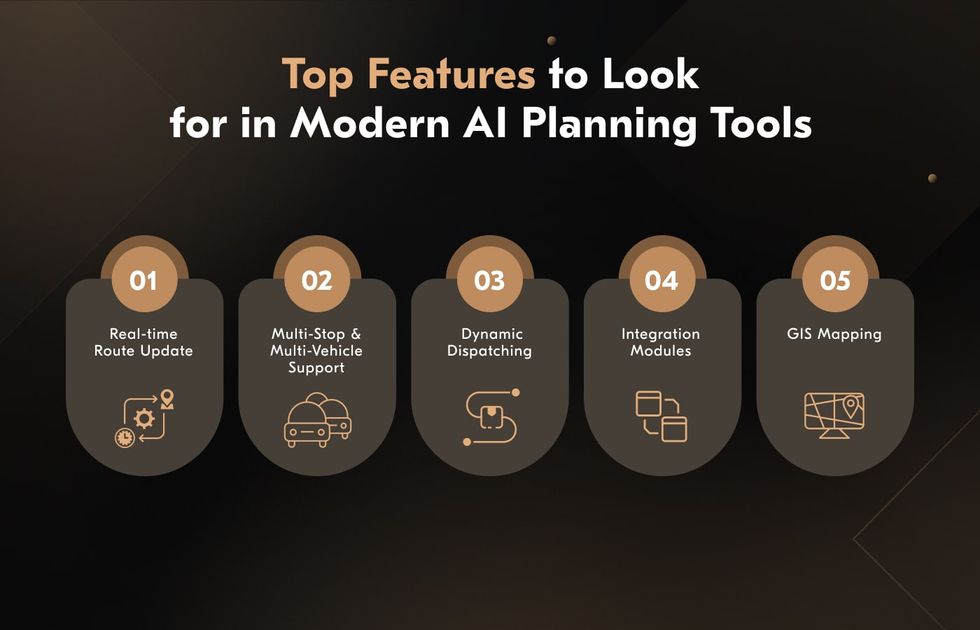
AI routing software, whether custom or off-the-shelf, is designed to solve complex logistical challenges with speed, precision, and adaptability. Here’s a breakdown of the core features that make these systems powerful tools for modern fleets.
Real-time Route Adjustments
This feature enables the system to ingest and analyze live data streams to automatically update routes in a live format. Functionally, this reduces delays, minimizes inoperative times, and keeps ETAs accurate without requiring manual dispatcher input.
Multi-stop & Multi-Vehicle Optimization
At its core, this capability applies advanced combinatorial algorithms and AI heuristics to generate optimal routes for fleets with multiple stops, drivers, and delivery constraints. It takes into account variables such as vehicle capacities, time windows, service durations, and geographical zones to minimize total travel time and mileage. This leads to higher delivery density per route, improved asset utilization, and reduced fuel and labor costs.
Demand Prediction & Dynamic Dispatching
The functionality of AI routing software must get the most out of historical delivery patterns, external data, and customer behavior to predict potential demand at a granular level — sometimes down to the SKU or address.
The system then can dynamically change scheduling and dispatching logic, allowing fleets to auto-reassign activities based on current conditions, vehicle availability, or changing workloads.
Integration with Fleet Management Tools & CRMs
Through APIs and native connectors, AI routing tools integrate with key enterprise systems such as fleet management platforms, customer relationship management software, order management systems, and ERP.
This bi-directional data flow enables syncing of customer information, driver status, vehicle diagnostics, and delivery statuses. Needless to say, this capability is crucial for better coordination across departments and enhanced automation.
AI + GIS Mapping
Using insights derived from artificial intelligence with Geographic Information System (GIS) data, the AI routing engine gains advanced spatial awareness. This includes road classifications, traffic patterns, urban density, terrain data, and routing restrictions.
Consequently, this improves the precision of route modeling and makes estimations more accurate.
How to Implement AI Route Optimization in Your Business
Indeed, embracing AI in logistics route optimization can change the way your business manages deliveries and field operations for the better. But to make it work for you, you need to choose the right tools, manage your data well, and prepare your team for the change.
Last but not least, partnering with a reliable vendor is key — at least in terms of consulting, as having a clear plan cuts the development costs! Here’s how to get started:
- Choosing the right tool or vendor. It all starts with picking the software that fits your business needs. Look for solutions that support multi-vehicle routing, real-time traffic updates, and can handle your specific delivery policies. As for web development partners, check their reputation on platforms like Clutch to ensure they have success cases and expertise in AI.
- Importance of data governance. Having clean location data, detailed vehicle information, and clearly defined delivery or service constraints are the musts. Prioritize setting up strong data governance practices to ensure the input feeding your AI system is consistent and error-free.
- Change management and team training. To get the most out of the system, invest time in training dispatchers and drivers on how AI-driven routing works and why it matters. Start with pilot programs to build confidence and gradually roll out the technology. If you work with an IT outsourcing agency, make sure they provide cohesive training.
Why Choose Acropolium?
At Acropolium, we bring together AI, IoT, and deep logistics know-how to help businesses run smarter, faster, and more efficiently. Our AI & ML case studies in the supply chain space show how intelligent automation can solve real-world challenges — from AI routing to inventory control.
With over 20+ years of experience on the market, our dedicated teams have a broad expertise in adopting cutting-edge technologies based on the needs of different industries. Focusing on compliance and business-continuity, we build secure, scalable apps from the ground up.
Now, let’s look at how SaaS and AI route planning reshape logistics in action.
SaaS-based Route Planning Tool
As our client’s logistics and fleet operations scaled up, they started seeing the cracks in their software. Routing inefficiencies, poor visibility, and rising fuel expenses made it tough to keep up.
To maintain service quality, they teamed up with Acropolium to build a smarter, AI-driven route optimization platform within a cloud-based infrastructure.
Solution
Our developers started out with a deep-dive discovery phase, mapping out bottlenecks, tech gaps, and growth goals. From there, we engineered a scalable solution to handle real-world logistics demands with precision and flexibility:
- Adopted AI route planning modules that learn and adapt in real-time, optimizing routes with every mile.
- IoT and live map data integration via Google Maps API and OpenStreetMap to keep routes dynamic and responsive.
- Cloud-native architecture on AWS to manage large volumes of data and scale effortlessly.
- Real-time fleet tracking with IoT sensors and dashboards for live updates on vehicle location and performance.
- Advanced analytics to help teams make data-backed decisions and continuously improve operations.
Results
- Profit margins rose by 15%, fueled by smarter routing and reduced fuel use.
- Customer retention climbed 25% as deliveries became faster and more dependable.
- Operational efficiency jumped 25% with improved scheduling and AI-powered route tracking.
Final Thoughts
From slashing hundreds of millions of miles on the road and trimming fuel bills, to boosting customer loyalty and scaling operations seamlessly, the data proves that AI routing delivers tangible ROI.
As market demand and customer expectations keep climbing, your task is to keep up with the tech pace of your industry operations. And Acropolium will be glad to support you in this journey, helping you reach new heights with sophisticated algorithms and best AI practices.
Apart from proven expertise, we offer cost transparency with our subscription-based cooperation model. Contact us today and let us show you the new horizons for your business!









![How to choose the Best Transportation Management Software [2025 Guide]](/img/articles/best-transportation-management-software/img01.jpg)


![Transport App Development [A 2025 Guide for Startups & Businesses]](/img/articles/transportation-app-development-guide/img01.jpg)
![Machine Learning in Logistics and Supply Chain [7 Use Cases Included]](/img/articles/machine-learning-in-supply-chain-and-logistics/img01.jpg)
![Logistics & Shipping APIs Integration Guide [2025]](/img/articles/logistics-and-shipping-apis/img01.jpg)